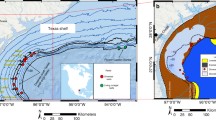Abstract
High resolution seismic data from Torres Strait off northern Australia provide the first insights into the development of the striking platform reefs of the region. In the southern part of Torres Strait, where the sea floor is shallow and featureless, the Torres Reefs have developed as long, narrow platforms parallel to very strong east-west flowing tidal currents. The reefs have expanded since the end of the post-glacial marine transgression (approximately 6000 years ago) through preferential growth at each end of their platforms. In these localized areas sheltered from the strong tidal currents, patch reefs have developed. Sediments swept from the reef margin and the inter-reef channels are deposited in these current lee areas at the ends of the reefs. The combination of the patch reefs and reefal sediments provides the essentials for extension of the platform reefs. The seismic data confirm that modern reef expansion is occurring without there being a high substrate for coral colonization. The evolutionary sequence from an uncolonized seafloor to a mature platform reef envisages a synchronous process of patch reef development and sediment accumulation.
Similar content being viewed by others
References
Chappell J (1983) A revised sea-level record for the last 300000 years from Papua New Guinea. Search 14, 3–4:99–101
Harris PT (1988) Sediments, bedforms and bedload transport pathways on the continental shelf adjacent to Torres Strait, Australia-Papua New Guinea. Cont Shelf Res 8:979–1003
Harris PT (1989) Sandwave movement under tidal and wind-driven currents in a shallow marine environment: Adolphus Channel, northeastern Australia. Cont Shelf Res 11, 7:655–662
Harris PT (1991) Reversal of subtidal dune asymmetries caused by seasonally reversing wind-driven currents in Torres Strait, northeastern Australia. Cont Shelf Res 9:981–1002
Hopley D (1982) The geomorphology of the Great Barrier Reef: Quaternary development of coral reefs. John Wiley, New York
Hopley D, Mc Lean RF, Marshall J, Smith AS (1978) Holocene-Pleistocene boundary in a fringing reef: Hayman Island, north Queensland. Search 9:323–325
Hopley D (1983) Evidence of 15000 years of sea level change in tropical Queensland. In: Hopley D (ed) Australian sea levels in the last 15000 years: a review. Department of Geography, James Cook University of North Queensland, Monogr Ser, Occ Pap 3:93–104
Hydrographic Services, RAN (1988) AUS 293 Australia-North Coast-Torres Strait-Prince of Wales Channel. Royal Australian Survey Corp
Jones MR, Holmes KH, Searle DE (1992) Prince of Wales Channel: seabed geology and morphology. Marine and Coastal Geology Unit, Project Report MA64/4
Jones MR, Torgersen T (1988) Late Quaternary evolution of Lake Carpentaria on the Australia-New Guinea continental shelf. Aust J Earth Sci 35:313–324
Komar PD (1974) Oscillatory ripple marks and the evaluation of ancient wave conditions and environments. J Sediment Petrol 44, 1:169–180
Komar PD, Miller MC (1973) The threshold of sediment movement under oscillatory water waves. J Sediment Petrol 43, 4:1101–1110
Maxwell WGH (1968) Atlas of the Great Barrier Reef. Elsevier, Amsterdam
Maxwell WGH (1973) Sediments on the Great Barrier Reef Province. In: Jones OA, Endean R (eds) Biology and geology of coral reefs, 1, Geology 1:299–346
Off T (1963) Rhythmic linear sand bodies caused by tidal currents. Bull Am Soc Petrol Geol 47:324–341
Queensland Department of Transport (1991) Queensland Tide Tables-1992. Queensland Government, Brisbane
Scoffin TP, Stoddart DR, Mc Lean RF, Flood PG (1978) The Recent development of the reefs in the Northern Province of the Great Barrier Reef. Phil Trans R Soc London B 248:129–139
Stride AH (1982) Offshore Tidal Sands: Processes and Deposits. Chapman and Hall, London
Willmott WF, Powell BS (1977) Torres Strait-Boigu-Daru Queensland. 1:250000 Geological Series Explanatory Notes. Australian Government Publishing Service, Canberra
Wolanski EJ, Ridd P, Inoue M (1988) Currents through Torres Strait. J Phys Oceanog 18:1535–1545
Author information
Authors and Affiliations
Rights and permissions
About this article
Cite this article
Jones, M.R. The Torres Reefs, North Queensland, Australia —strong tidal flows a modern control on their growth. Coral Reefs 14, 63–69 (1995). https://doi.org/10.1007/BF00303424
Accepted:
Issue Date:
DOI: https://doi.org/10.1007/BF00303424




